Flag of Argentina
| Flag of Argentina | |
|---|---|
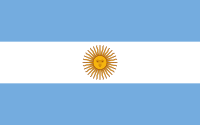 |
|
| Vexillological symbol : |
|
| Aspect ratio: | 9:14, depending on the flag size, the proportions 2: 3, 13:20 and 9:13 are also possible |
| Officially accepted: | February 25, 1818 (version with sun) |
The flag of Argentina shows three horizontal stripes of equal width: light blue ( Spanish celeste , sky blue ') above and below, white in between.
Above the white stripe in the middle of the flag is a sun with alternating 16 straight and 16 flamed sun rays. It is said that the general and politician Manuel Belgrano was inspired to create this symbol when he looked at the sky during the Battle of Paraná . In earlier flags of Argentina and as the country's coat of arms , a similar sun symbol was already used with the Sol de Mayo (maisonne, also known as the Inca sun ). The representation of the sun is identical to the sun on the first Argentine coins. The sun disk with a face surrounded by rays of the sun symbolized the son Inti of the divine creator Viracocha in Inca mythology .
In the past, the flag without the sun was used in peacetime and the flag with the sun in wartime . Later, a distinction was made between flags used in an official capacity (with sun) and flags for private use (without sun). Today, both versions can be used at will.
history
On May 25, 1810 , the story of the Argentine flag began with the first attempts to gain independence from Spain through an uprising in Buenos Aires . Initially, two-tone flags were used, showing the colors of the city of Buenos Aires, white and red, which had been in use since the British occupation in 1806/1807. For the representatives of the independence effort, red symbolized freedom and white symbolized unity.
In August 1810, José de Moldes , a representative of the faction that wanted to break unconditionally with Spain, formed two military units, which he equipped with a light blue and white cockade as a distinguishing mark. Light blue stood for the provinces of the Río de la Plata and white for the tyranny of Spain . In December of the same year he also asked the Provisional Government to create a national cockade in these colors.
After the ban on the light blue and white cockades by Cornelio Saavedra , who did not completely break with Spain and wanted a gradual transition to more independence, these were replaced in April 1811 by monochrome red cockades, as used by the Spaniards, and provided with white ribbons.
On February 18, 1812, the junta , the first provisional government, whose members were Feliciano Antonio Chiclana , Manuel de Sarratea Altoguirre and Juan José Paso , stipulated that instead of the red cockade, one with the colors light blue and white should be used again:
|
|
Manuel Belgrano , the spokesman for the junta, was inspired by this to create a flag. On February 27, 1812, a light blue and white flag was hoisted for the first time near the city of Rosario when two forts were inaugurated there. He informed the junta:
|
|
The government disapproved of this act as politically imprudent and recommended that Belgrano remove the flag and use the red and yellow flag of the fortress in Buenos Aires, the colors of Spain. However, Belgrano never received the order of March 3 not to use this flag, and so he had a flag made that was hoisted in the city of San Salvador de Jujuy on the second anniversary of the May Revolution (May 25, 1812) . The government interpreted this as a refusal to order and on June 27th asked him again not to use this flag. On July 18, 1812, Belgrano replied that he was ready to lower the flag and would not use it until the day of the last battle.
On the second anniversary of the May Revolution of Buenos Aires on May 25, 1812, Belgrano had a white flag made with the seal of the Sovereign Assembly and blessed by Canon Juan Ignacio de Gorriti in the main church of San Salvador de Jujuy on the anniversary. This flag, known as the Bandera Nacional de Nuestra Libertad Civil , was presented to the Juyan people in 1813 as thanks for their support in the struggle for independence, particularly in the Battle of Salta . The flag is now kept in the Flag Hall of the Governor's Palace of Jujuy and is now the flag of the Jujuy Province . The seal depicted on the flag shows two hands shaking in the middle, symbolizing the unity and brotherhood of the Argentine provinces. Both hands hold a stick on which a Phrygian cap lies. The staff should represent the readiness to defend freedom. Based on the Jacobins during the French Revolution, the hat is supposed to symbolize the republican sentiment of the Argentines. The hands stand in front of a two-part background, with the colors light blue and white, the colors of the sky. At the top of the ellipse you can see a rising sun, a symbol that can also be found on the flag of Argentina. The rising sun symbolizes the rise of Argentina. Laurel, which represents the victory in the struggle for independence, is entwined around the ellipse.
In January 1813 Belgrano had a third flag made, which, after consultation with the government, he carried with him not as the state flag, but as the flag of his armed forces. But the people saw this flag as the national flag, even if it only had two stripes and not three stripes, as is the case in Buenos Aires. Belgrano swore his troops on this flag on February 13 and led them into battle for the first time on February 20, 1813. This flag was last used on November 13, 1813, at the Battle of Ayohuma .
From April 1813 the use of the Inca sun / May sun is proven on coins. The solar disk with a face surrounded by rays of the sun, symbolized in Inca mythology the son of Inti the divine creator Viracocha . The first Argentine coins later served as a template for the sun in the flag.
On July 9, 1816, the Congress of Tucumán declared the independence of the Provincias Unidas del Río de la Plata (name of Argentina around 1816) from Spain , which was severely weakened after French rule by Napoleon's brother Joseph Bonaparte and the Spanish War of Independence . Congress accepted the light blue, white, and light blue flag as the national flag on July 20, 1816. The text of the resolution reads as follows:
|
|
The Andes Army (Ejército de los Andes) of the South American freedom fighter José de San Martín used a light blue and white flag in 1817 and 1818, but it did not have a third light blue stripe, although in 1816 the light blue, white and light blue flag had been passed by Congress. It was marked with the seal of the government and is now the flag of the province of Mendoza .
On January 9, 1818, the Supreme Director of the Pueyrredón government asked Congress to determine how to use the flag. Congress responded on February 25, 1818 that the national flag should have two colors, white and blue, as before, and that the war flag should have a sun in the center.
- Original text: “… en orden a las diferencias de las banderas nacionales ya la divisa de los generales en campaña, el que expuso sobre lo primero, que era del parecer que sirviendo para toda bandera nacional los dos colores blanco y azul en el modo y forma acostumbrada fuese distintivo peculiar de la bandera de guerra un sol pintado en medio de ella, cuyo proyecto, adoptado por la sala después de algunas reflexiones, quedó aprobado. "
Even if the term blue is used here, light blue was still meant and not the dark blue that was used in the period from 1830 to 1878.
Especially in the early days up to 1830, many official and unofficial variants of the national flag were in use. Frequent but incorrect variants were that the sun was shifted slightly to the left of the center or that the sun protruded beyond the white stripe into the light blue stripes. In 1826 the name República Argentina (Republic of Argentina) appeared for the first time ; previously it was spoken exclusively of the Provincias Unidas del Rio de la Plata (United Provinces of the Río de la Plata).
Since 1828 Juan Manuel de Rosas appeared as the commander of the rural population and leader of the federalists in the fight against the faction of the so-called Unitarians. In December 1829 he became governor of Buenos Aires . In March 1835 he was re-elected governor and captain general . At times, Rosas allowed herself to be transferred to extraordinary power and thus in fact received the power of a dictator . Rosas hated the light blue color because it was used by the Unitarians and that is why a darker shade has been used since he came to power. In 1836 the flag was supplemented by four Jacobin hats on bars in the corners. A little later, the rods were replaced by arrows and red rays of the sun were added to the sun. From 1840 the sun was shown completely red. Because Rosas refused to recognize the independence of Uruguay , France, Great Britain, Paraguay, Uruguay and Brazil declared war on Rosas' Argentina. After the lost war, Rosas could not stay in power for long, and so his rule was ended by the Unitarian Justo José de Urquiza in 1853.
The Argentine Confederation (Confederación Argentina) , which was rejected by Buenos Aires, again gave itself the traditional light blue, white and light blue flag. But the independent Buenos Aires also uses this flag. In 1862, Buenos Aires rejoined the other provinces. Around 1862, with the emergence of a stronger central power in Argentina, the provincial flags gradually disappeared.
By decree of the President Julio Argentino Roca , the flag with the sun was also used on public buildings from 1884, it was no longer a war flag. In 1943 this was confirmed by a decree. The flag with no sun was now intended for citizens' use. From now on, the national flag was the flag with the sun. Since 1985, citizens have also been allowed to use the flag with the sun:
|
|
Relationship of the Argentine people to their flag
As in many other former colonies of European countries, the Argentine flag has a special meaning for the population. The ancestors of the vast majority of Argentines did not originally come from the indigenous people, but came from mostly European countries (according to official statistics, about 90% of today's population). In Argentina, the countries of origin Spain (29%) and Italy (36%) are particularly well represented, but immigrants from France , Great Britain and Germany also make up a relatively large proportion.
Because the inhabitants have different cultural backgrounds, the national symbols play a particularly strong role in identifying with home Argentina. The anthem and flag in particular appeal to the national sentiments of most Argentines.
In school it is particularly evident how strong the flag acts as a unifying bond for this relatively young nation. So the flag is present at every school act. It is carried by the so-called "Abanderado" (flag bearer). This is usually the best student in the respective school, and this position is not only considered a special honor for that reason. At all private and state schools, the flag is hoisted every morning in the presence of all students and is brought down again in the evening.
On June 20 of each year, "Flag Day", fourth grade students pledge their loyalty to the flag and the Argentine nation with the words:
|
|
The promise is followed by the singing of the national anthem Himno Nacional Argentino .
Every Argentinian is taught from an early age to honor and love the flag and the country it represents.
Influence of the Argentine flag on the flags of other states
After the naval operations under the French-born, Argentine commander Louis Michel Aury (other spelling: Luis Aury), the Argentine flag became the model for the blue-white-blue flag of the first independent state in Central America, which was founded in 1818 and located on the island of Providencia off the east coast of today's Nicaragua . This state existed until around 1821, before Greater Colombia took control of these islands. A little later (1823) this flag was again the model for the flag of the Central American Confederation (Provincias Unidas del Centro de América) , a confederation of the Central American states of Guatemala , Honduras , El Salvador , Nicaragua and Costa Rica , which existed from 1823 to 1838. Therefore, the Argentine flag is still used today in the flag of Guatemala , the flag of Honduras , the flag of El Salvador , the flag of Nicaragua and the flag of Costa Rica .
 |
 |
 |
 |
 |
 |

|
| Central American Confederation |
|
Flag of Guatemala | Honduras flag | Flag of El Salvador | Flag of Nicaragua | Flag of Costa Rica |
The Argentine flag was also used in Chile during the War of Independence, for example in the Battle of Chacabuco .
The first flag of the Republic of East Uruguay ( Uruguay for short; República Oriental del Uruguay ) was very similar to the current flag of the Entre Ríos province , only the blue was a little darker to differentiate it from Argentina. This flag is called the Artigas' flag . Today's flag is designed a little differently, but the blue and white stripes and the May sun still indicate the common history with Argentina.
Argentine Flag Day
Since a law passed by President Roberto María Ortiz on June 8, 1938, June 20 (the anniversary of Manuel Belgrano's death) is the day of the flag (Día de la Bandera) of each year . On this day, celebrations in honor of the flag and Manuel Belgranos are held across the country. Many Argentines attach small bows in the colors of the flag, hang the flag out of the window and in schools the students swear loyalty to the flag.
On Flag Day in 1957, the National Monument of the Argentine Flag ( Monumento Nacional a la Bandera ) in Rosario was inaugurated by the then de facto President Pedro Eugenio Aramburu . Since then, the central celebrations in honor of the Argentine flag have taken place at this monument.
The day of the Argentine cockade is May 18th.
Trivia
- A law stipulates that the sun must be embroidered on flags for particularly representative purposes and that the front and back must not be mirror-inverted, i.e. i.e., the flamed rays must be bent in the same way on both sides.
- Probably the most expensive flag of Argentina is only a few square centimeters tall and made of diamonds , sapphires and platinum . (Image: http://members.fortunecity.com/evita2/brochear.html ( Memento from July 24, 2004 in the Internet Archive ) ) This valuable brooch belonged to the wife of the former President of Argentina Juan Domingo Peróns , Eva Perón or Evita for short, loved by her commitment to lower social classes. The brooch was for 900,000 in 1998 dollars at Christie's auction.
- On the day of the Argentine flag in 2001, a 3500 meter long flag was carried by the people present. In 2005 the flag called Alta en el Cielo (high in the sky) reached a length of 10,000 meters. This makes it the longest flag in the world.
Argentina's flag in music
There are also songs and marches dedicated to the Argentine flag. The best known is the Mi Bandera march :
Mi Bandera
Music: Juan Imbroisi
Link to the MIDI file ( Memento from March 11, 2016 in the Internet Archive )
(Please note copyrights )
|
Mi Bandera Aquí está la bandera idolatrada, |
My flag Here is the so dearly loved flag, |
| Aquí está la bandera esplendorosa que al mundo con sus triunfos admiró, |
Here is the shining flag who surprised the world with her victories |
| Aquí está la bandera que un día en la batalla tremoló triunfal |
Here the flag is the one in a day was hoisted triumphantly in battle |
| Aquí está, como el cielo refulgente, ostentando sublime majestad, |
Here it is like the bright sky shows outstanding majesty |
First performance: 1906, text: 1859 by Juan Chassaing (1838–1864), music: Juan Imbroisi (1866–1942).
Other pieces of music dedicated to the flag are the March La Bandera by GJ García, the song Saludo a la Bandera by Leopoldo Corretjer, Canción a la Bandera from the opera Aurora by Hector Panizza (text by HC Quesada and L. Illica) as well Bandera de mi Nación by Julio C. Navarro.
In addition, there are poems dedicated to the flag and the traditional promise of the Argentine schoolchildren on Flag Day.
Official colors of the flag
The official colors of the Argentine flag are:
| Official colors ( Pantone ) | Web: | RGB | |||
|---|---|---|---|---|---|
| 252-191-73 | 117-170-219 | 132-53-17 | 255-255-255 | ||
| RGB hexadecimal | |||||
| FCBF49 | 75AADB | 843511 | FFFFFF | ||
| Material: | 14-1064TC | 16-4132TC | 18-1441TC | ||
| Graphic: | 1235C or 116U | 284C or 284U | 1685C or 1675U | ||
| Plastic: | Q03021 | Q30041 | Q12024 | ||
Flags of the Argentine provinces
In Argentina there is no consistent tradition of the provinces to fly a flag. Most provinces have only recently had a flag. However , each province has a coat of arms .
| Province name | Location of the province | flag | Aspect ratio |
Flag in use since * | Comments |
|---|---|---|---|---|---|
| Autonomous City of Buenos Aires |  |
 |
11:17 | 1980 (coat of arms goes back to 1580) | The flag was introduced by Juan de Garay on the 400th anniversary of the city's founding . But you see them much less often than the city arms.
The flag depicts an eagle surrounded by its children. The eagle comes from the coat of arms of the Habsburgs , to which Emperor Charles V belonged. Buenos Aires was founded by Spain in 1536 and Charles V was King of Spain at that time.As a symbol of colonialism and monarchism, it is not undisputed. |
| Buenos Aires |  |
 |
2: 3 | 1997 | The flag was the winning entry in a competition that attracted 270,000 young people between the ages of 12 and 18. The four best of the total of 81,525 proposals were put up for election in 1997. One of the conditions in the competition was that the flag of the province should not resemble the national flag.
The colors of the flag have the following symbolism: green for the fields of the region, blue for the rivers, the sea and the sky, red for federalism, yellow for fertility. The laurel wreath stands for the fame of the province of Buenos Aires, the gear wheel stands for industrial production and the sunflower for agricultural yields. |
| Catamarca |  |
 |
6:11 | 2011 | Catamarca was the last province in Argentina to have a flag. The flag is divided into three fields and is surrounded by a golden border, symbolizing the richness of the province's cultural heritage. The upper half is sky blue and white, which symbolizes the sky, the national flag and the cloak of Mary. In the lower half there is a blood-red stripe that represents "the mixture of our blood". In the center is the sun of the Argentine national flag, which is inspired by the Inca sun, lined with olive branches with 16 leaves, which represent all departments of the province. |
| Chaco |  |
 |
2: 3 | 2007 | After the criticism of the previous flag from 1995 was very strong and it was therefore practically not used, this new flag was adopted on September 19, 2007. The design of the flag shows the symbolism that identifies the province of Chaco. It shows the sun of the Argentine national flag on a green, white and light blue tri-color in the center and below a wooden plow, which is circled by 25 stars representing the 25 departments. The colors white and light blue are reminiscent of the national flag and at the same time of the cotton grown in the Chaco (white), the rivers of the province (blue) and the fertile soils of the province (green). |
| Chubut |  |
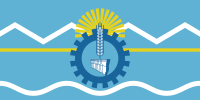 |
1: 2 | 2004 | On December 21, 2004, a law was passed that raised the winning entry in the government-run competition for the provincial flag. The law describes the new flag as follows: In the center of the flag is a cog wheel, which symbolizes industrial production. Behind and above the cog is a rising sun, the 15 rays of which represent the 15 departments of the province. Under the rising sun are the identifying attributes of the provincial coat of arms: the Florentino Ameghino dam and a stalk of wheat. These symbols are on a light blue background, which is broken by three lines. In the middle a yellow line, which represents the rivers, especially the Río Chubut . The upper white zigzag line represents the mountain ranges of the Andes , the lower white wave line represents the waves of the Atlantic . |
| Cordoba |  |
 |
11:17 | 2010 | In 2010 a new flag was passed for the province of Cordoba. The design resulted from a competition. The flag has three vertical stripes in the colors red-white-blue. The white stripe shows the silhouette of a "Jesuit sun" with 16 straight and 16 curved rays. |
| Corrientes |  |
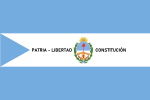 |
2: 3 | 1986 (goes back to a flag from 1823) | Provincial flags can be found for Corrientes since January 1815. The first was light blue-red-white. From February 1815, variations of the national flag can be found. From 1822 a light blue-white-light blue flag with the provincial coat of arms in the middle was used. In 1823 the coat of arms was replaced by a triangle on the left edge. From 1860 this flag was only used very rarely. In 1986 the current flag was officially introduced. It resembles the flag from 1823, but also has the provincial coat of arms and the motto Patria, Libertad y Constitución (Fatherland, Freedom and Constitution) in the middle. |
| Entre Ríos |  |
 |
1: 2 | 1987 (goes back to a flag from 1814) | The flag of Entre Rios goes back to the flag of the Liga Federal (Federal League), which was created on 1814 by José Gervasio Artigas , the founder of today's Uruguay ( see also : Flag of Uruguay ). This flag was in use from 1815 to 1821 and 1824. Thereafter, the province did not have its own flag until 1833, when a three-striped flag was introduced, which was valid until about 1853. It was divided vertically; on the left the flag was identical to the national flag and on the right it was red-white-red. However, this flag was little used. In 1987, the old flag from 1815 became the official provincial flag. |
| Formosa |  |
 |
6:11 | 1991 | This flag emerged as a winning entry from a competition. The bay leaves symbolize the Tropic of Capricorn , the white triangle the conical shape of South America, the nine stars the nine departments of the province. The colors light blue and white come from the national flag. |
| Jujuy |  |
 |
5: 4 | 1960 (goes back to a flag of Manuel Belgranos) | The flag, adopted in 1960, goes back to the white flag with the seal of the Sovereign Assembly that was raised by Manuel Belgrano on July 25, 1812 . The original is now in the Governor's Palace in San Salvador de Jujuy . |
| La Pampa |  |
 |
9:14 | 1993 | The province's flag, adopted in 1993, is identical to the national flag and has the province's coat of arms in the middle. The design came from Luis Alberto Galceran. |
| La Rioja |  |
 |
9:14 | 1986 | At the beginning of the 19th century, La Rioja was part of the province of Cordoba. Therefore no own flag was flown. It wasn't until 1986 that its own flag was adopted. It has two horizontal stripes, the top white and the bottom blue. A red bar ascending from the bottom left lies diagonally on this strip. In the middle there are two branches of laurel, which symbolize the 18 departments of the province with their flowers . |
| Mendoza |  |
 |
5: 4 | 1992 (goes back to a flag of José de San Martín) | The flag, adopted in 1992, is an identical reproduction of the flag of the Andean Army of the South American freedom fighter José de San Martín , which he used in 1817 and 1818. The flag has two horizontal stripes (white and light blue) with the government's seal in the center . |
| Misiones |  |
 |
2: 3 | 1992 (goes back to a flag from 1815) | The flag, which has been official since 1992, has three horizontal stripes in blue, red and white. It goes back to a flag that was handed over in 1815 by José Gervasio Artigas , the founder of today's Uruguay , to the then head of government of the province of Misiones, Andrés Guazurary (= Andresito Artigas). Andresito used the flag in several battles until 1819 when the province was conquered by the Portuguese. After the reconquest, it was in use until 1832 when Misiones in the province of Corrientes rose. |
| Neuquén |  |
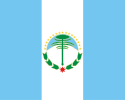 |
4: 5 | 1989 | The flag is divided into three vertical stripes, which are officially in the colors of the national flag light blue-white-light blue, but are in fact used in the colors blue-white-blue. In the middle is the silhouette of the Pehuén or Araucaria , a typical tree of the province. Behind the tree is the Lanín Volcano . The tree and the volcano are framed by a central red star, which represents the Federation, green leaves on both sides and at the top by 16 yellow stars, which represent the 16 departments of the province. |
| Río Negro |  |
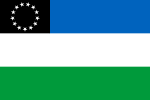 |
2: 3 | 2009 | The Río Negro flag was the winning entry in a competition with 164 entries. The flag is blue-white-green with a black flag field (" Gösch ") in the upper left corner, which shows 13 white stars in a circle. The 13 stars symbolize the 13 departments. The upper blue stripe represents justice as well as the lakes, rivers and irrigation canals of the province, the middle white stripe the amount of all colors and the lower green stripe the hope and the wealth of the earth and its agricultural use. The black of the flag field represents the Río Negro , the "black river". |
| Salta |  |
 |
5: 7 | 1997 | The flag emerged as a winning entry from a competition with more than 4,000 entries. The flag combines the elements that represent Salta: the coat of arms of the province (in the middle of the flag), the Baltic poncho (the red cloth with the black stripes), and the 23 departments (23 gold stars). |
| San Juan |  |
 |
9:14 | 1997 | The flag is inspired by the flag of the Andean Army, but is based on the three-striped national flag and shows the provincial coat of arms in the middle, crowned by the Inca sun with 19 rays for the 19 departments. Under the coat of arms is En Unión y Libertad (In community and freedom). The back of the flag shows a faceless sun in the center with 32 straight rays. (The flag shown on the left is a not entirely correct reconstruction.) |
| San Luis |  |
 |
2: 3 | 1988 | The flag shows the provincial coat of arms on a white background. The coat of arms (1939) shows a typical landscape of the province with animals that are now extinct in the province ( venados or pampas deer ) in front of four mountains over which a sun shines. |
| Santa Cruz |  |
 |
2: 3 | 2000 | The flag is the winning entry in a competition with 149 participants. The flag shows the rising sun in the middle on a light blue background, which surrounds the mountain Fitz Roy (also called Chaltén) in a semicircle , above which the Southern Cross stands on the night firmament . In the lower part of the flag, the waves of the Atlantic are symbolically represented. |
| Santa Fe |  |
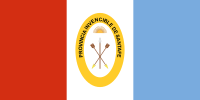 |
1: 2 | 1986 (goes back to a flag from 1822) | The flag of Entre Rios was hoisted as the province's first flag in 1815 when José Gervasio Artigas , the founder of what is now Uruguay , took power in the province. In 1821 a new flag was put into use, which resembled the three-stripe of the national flag, but without the sun in the middle and with a red triangle on each side with the tip pointing inwards. The forerunner of today's flag was introduced in 1822. It has three vertical stripes in red, white and light blue. In the white stripe there is a yellow oval with the inscription Provincia Invencible de Santa Fe (Invincible Province of Santa Fe), in which are the weapons, over which the rising sun shines. The flag was probably no longer used from 1890 and was not officially reintroduced until a hundred years later. |
| Santiago del Estero |  |
 |
2: 5 | 1986 | The flag was adopted in 1986 on the initiative of Provincial Representative Dario Augusto Moreno. It shows three vertical stripes in the colors of the national flag light blue-white-light blue. On the white stripe there is a red stripe, in the middle of which a red Jacob's cross is depicted on a golden sun . The sun has 8 straight and 8 flamed rays. |
| Tierra del Fuego |  |
 |
27:40 | 1999 | The flag emerged as a winning entry from a competition. It shows an orange-blue flag, which is divided diagonally descending by a stylized white albatross . The southern cross is shown in the upper right (blue) field . |
| Tucuman |  |
 |
9:14 | 2010 | The colors of the new flag from April 13, 2010 are the inverted colors of the Argentine flag and correspond to the so-called Bandera de Macha . This flag was used by Manuel Belgrano's troops in two battles in 1816. The current flag replaces the previous flag of Tucumán, which was abolished in 2008 due to its Christian symbolism. |
* This means the use in its current form. Many provinces had flags much earlier, but they were often not in use for decades.
See also
Individual evidence
- ↑ “El 31 de diciembre de 1810 José de Moldes desde Mendoza requirió al gobierno que aprobara una escarapela nacional 'que he formado con alusión al Sur, celeste, y las puntas blancas por las manchas que tiene este celaje que ya vemos despejado'” ( Request from José de Moldes, Deputy Governor of Mendoza, to the members of the Junta Provisional de las Provincias del Río de la Plata , Mendoza, December 31, 1810, in: Guillermo Palombo y Valentín A. Espinosa, Documentos para la historia de la bandera argentina, Buenos Aires, 2001, documento 9, pp. 27-28). Quoted in: http://cebanet.blogspot.com/2007/05/bandera-nacional-proyecto-de-ley.html .
- ↑ http://www.casarosada.gov.ar/index.php?Itemid=41&id=21&option=com_content&task=view Website of the Argentine President.
- ↑ http://www.mininterior.gov.ar/agn/escuela_belgrano.asp ( Memento from September 19, 2009 in the Internet Archive ) Page of the Argentine Ministry of the Interior.
- ^ Photos of the original flag ( memento from January 10, 2007 in the Internet Archive ).
- ↑ Símbolos Patrios ( Memento of April 4, 2008 in the Internet Archive ) First decree regarding the Argentine flag.
- ↑ LEGISLACION SOBRE LA BANDERA NACIONAL ( Memento of 18 August 2007 at the Internet Archive ) decision of the Congress on 25 February 1818th
- ↑ LEGISLACION SOBRE LA BANDERA NACIONAL ( Memento of August 18, 2007 on the Internet Archive ) Law No. 23.208, first article.
- ↑ http://www.gob.gba.gov.ar/legislacion/legislacion/98-2785.html Established for example in decree 2785/98 of the province of Buenos Aires.
- ↑ http://www.me.gov.ar/efeme/20dejunio/canmibandera.html Music and poetry on the Argentine flag.
- ↑ NORMAS IRAM ( Memento of 6 April 2009 at the Internet Archive ) Official colors of the flag.
- ↑ Camps, Adrián “Modifying the flag of the Autonomous City is proposed” ( Memento of March 25, 2011 in the Internet Archive ), accessed on January 10, 2011.
- ↑ Camps, Adrián “Modifying the flag of the Autonomous City is proposed” ( Memento of March 25, 2011 in the Internet Archive ), 2010, accessed on January 10, 2011.
- ↑ Año de la creación de la Bandera de la Provincia del Chaco ( Memento of June 19, 2009 in the Internet Archive ) Information about the new flag of the province of Chaco.
- ↑ N ° 26.940 ( Memento of June 14, 2007 in the Internet Archive ) Reglamentación Ley N ° 5930 Uso y Tratamiento de la Bandera de la Provincia de Mendoza.
- ^ Río Negro online from March 26, 2009: "Río Negro ya tiene su bandera" ( Memento from March 30, 2009 in the Internet Archive ).
- ^ Tucumán tiene su 'Bandera Histórica' .
- ↑ File: Bandera tucuman.svg (flag of Tucumán from 1995 to 2008).
literature
- Carlos A. Ferro: Historia de la Bandera Argentina. Ediciones Depalma, Buenos Aires 1991, ISBN 950-14-0610-5
- Pedro Ignacio Galarza: Historia de la bandera nacional según el Archivo Capitular de Jujuy. in: Instituto Nacional Belgraniano - Segundo Congreso Nacional Belgraniano, 1994. El Instituto, Buenos Aires 1995, ISBN 950-04-0703-7
- Dardo Corvalán Mendilaharsu: Los símbolos patrios. in: Academia Nacional de la Historia - Historia de la Nación Argentina (desde sus orígenes hasta la organización definitiva en 1862). El Ateneo, Buenos Aires, 1962.
- Guillermo Palombo and Valentín A. Espinosa, Documentos para la historia de la bandera argentina , Buenos Aires, 2001, ISBN 987-98761-0-5 .












